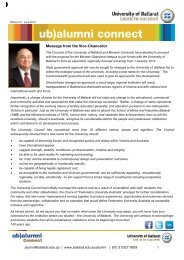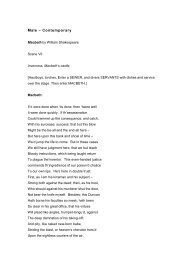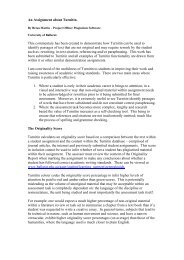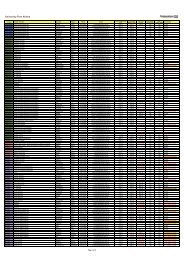Issue 8 Hotch Potch - University of Ballarat
Issue 8 Hotch Potch - University of Ballarat
Issue 8 Hotch Potch - University of Ballarat
You also want an ePaper? Increase the reach of your titles
YUMPU automatically turns print PDFs into web optimized ePapers that Google loves.
The Quakers originally developed solitary confinementas an alternative to the squalid conditions inprisons around the turn <strong>of</strong> the 19th century. Theyfocused on punishment and reformation. The darkcell at old <strong>Ballarat</strong> Gaol is underground; local historiansand archeologists have as yet been unableto obtain permission to go in and survey the roomand report on its condition. No-one has been downthere since the 1970s. There are only two other intactdark cells in Victoria; one at Castlemaine andone at the notorious J Ward in Ararat. The originaliron lacework gates <strong>of</strong> the Gaol are still standinghowever, as are the watchtower, turnkey’s residence,governor’s residence, and parts <strong>of</strong> the originalwall. These have been incorporated into theGaol’s current reincarnation as a university.The prison was a panopticon. Designed by JeremyBentham, a British philosopher and social reformerin the 1700s, this was the perfect design asit required less staff to observe inmates due to itsunique characteristics. The <strong>Ballarat</strong> Gaol was builtusing the same plan as Pentonville in the UK, whichwas modeled on the Eastern State Penitentiary inAmerica. This involved a central tower where theguard would sit, with the cell wings radiating outfrom the tower. This meant that the guard couldlook to any direction at any given time; the prisonerscould see the tower but not whether anyonewas inside (<strong>of</strong>ten there was not) due to the layout.The access and egress to the tower were masked byzigzagged openings with no doors or lights; this ensuredthat the inmates would never know when orif a guard was entering or exiting the tower, lendingto the idea that they were forever being watched.Prisoners would always have the central towerlooming before them as a reminder <strong>of</strong> their loss <strong>of</strong>freedom and identity.Michel Foucault in his 1975 work Discipline andPunish: The Birth <strong>of</strong> the Prison, said <strong>of</strong> panopticismthat ‘the effect is to induce in the inmate a state<strong>of</strong> conscious and permanent visibility that assuresthe automatic functioning <strong>of</strong> power…to arrangethings that the surveillance is permanent in its effects,even if it is discontinuous in its action’. Prisonerswere given jobs to do in their cells and guardswould check on them 4-5 times every hour. To addto the mental uncertainty <strong>of</strong> being watched constantly,guards would remove their shoes, wearingonly socks on their rounds so as not to make anynoise under foot as they were approaching. Prisonerswould only know <strong>of</strong> the guards’ approach oncethey could see them peering into the cell. Theywere in their cells for up to 23 hours a day, with noaccess to sunlight.By Kim SavageCreative CornerPhotos by Teghan Johns9
















